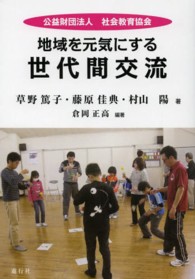- ホーム
- > 洋書
- > 英文書
- > Business / Economics
Full Description
Echinodermata have a rich fossil record, play major ecological roles in marine benthic communities from the intertidal to the deep sea, have economic importance in fisheries and aquaculture, show unique biological characteristics and have become important models in biomedical research.
These proceedings of the 12th International Echinoderm Conference (Durham, New Hampshire, USA, 7-11 August 2006) includes recent advances made in research of echinoderms, and is organized into six sections:
- Paleontology
- Systematics and Morphology
- Physiology and Nutrition
- Development, Molecular and Genetics
- Fisheries and Aquaculture
- Ecology and Environmental Studies
The book is of interest to academics and students interested in echinoderm biology and palaeontology.
Contents
Foreword; Echinoderms Today; Historical Retrospect; Austin Hobart Clark (1880-1954): His echinoderm research and contacts with his collegues; Paleontology; Echinoderm evolution since 1972 and since the cambrian: Tales from a dozen IECs; Almost within grasp: Crinoid organs rendered 3-dimensionally; Bdellacoma in the Hunsrück Slate (Lower Devonian): Reidentification of Urasterella verruculosa (Asteroidea, Bdellacomidae); Preliminary report on new echinoderm Lagerstätten from the Upper Ordovician of the eastern Anti-Atlas, Morocco; Paleoenvironment of fossil ophiuroids in Plio-Pleistocene Hijikata Formation in Shizuoka Prefecture, Central Japan; New Ordovician mitrates (Echinodermata, Stylophora) from the Ancenis Basin (South Armorican Domain, France): Palaeogeographic and palaeoenvironmental implications ; Reappraisal of ambulacral branching patterns in blastozoans ; Evolution and diversification of ophiocistioids (Echinodermata: Echinozoa); The early evolution and diversification of holothurians (Echinozoa); The 'Swabian Caput Medusae' (Jurassic Crinoidea, Germany); Cyclocystoids (Echinodermata: Echinozoa) from the Silurian of Gotland, Sweden; Epibionts on Late Carboniferous through Early Permian echinoid spines from Texas, USA; Echinoderm remains in the offerings of the great temple of the Aztecs 77; Abstracts: A crinoid - starfish assemblage from the upper Silurian of Gotland; Phylogeny of Lower Palaeozoic asterozoans using skeletal homologies derived from the Extraxial-Axial Theory; Notes on mid- and late Cretaceous ophiuroids from Shikoku, Southwest Japan; Food composition of crinoids in relation to stalk length and fan density: Their paleoecological implications; Biomarkers in colored crinoids of Indiana (Borden Group, Mississippian); Development and functional morphology of sutural pores in and middle Cambrian gogiid eocrinoids from Guizhou Province, China; Evolution of echinoids in the Triassic and early Jurassic: Just how biased is the fossil record?; A model for elemental homology for the peristome and ambulacra in blastozoan echinoderms ; New ophiuroids from the Pliensbachian of the French Ardennes: A preliminary report; A Mesozoic history of the ophiuroids; Systematics and Morphology; Speciation in sea urchins; Isla del Coco (Costa Rica) Echinoderms: State of knowledge; Tubes, sacs, cones, pyramids, and proboscises: Toward a homology-based understanding and terminology for plated, erect hindgut structures among the Crinoidea; Relationship between the preservation of spatangoid spines and water temperature; Crown-group asteroid phylogeny: An enduring quandary; Species of the complex Amphipholis squamata (Ophiuroidae) from Marseilles; On two new records of Family Brisingidae (Echinodermata: Asteroidea) from the Brazilian continental margin; ROV imaging of deep-sea echinoderms from the Brazilian continental margin, Southwest Atlantic; Cavalcanti & Morphology of the juxtaligamental system in the ophiuroid Amphipholis kochii; Comparing substitution rates in spatangoid sea urchins with putatively different effective sizes, and other echinoderm datasets; Development and evolution of the muscle system in the Echinodermata; Small-scale morphological differentiation in three brooding sea star species with limited dispersal; Southwest Atlantic deep-sea brittle stars (Echinodermata: Ophiuroidea) from Campos Basin, Brazil ; The digestive system of the ophiuroid Amphipholis kochii: Morphology and regeneration; Phylogeography of Pisaster ochraceus Brant, 1835 (Echinodermata: Asteroidea); Ophiacanthidae (Echinodermata: Ophiuroidea) collected from the Sagami Sea, Central Japan: A preliminary report; Organs of the axial hemal complex in crinoids - structure and occurrence; The establishment of a neotype for Luidia clathrata (Say, 1825) and a new species within the genus Luidia (Asteroidea: Paxillosida: Luidiidae); Morphological dimensional differences between Encope emarginata (Leske) from the Western Caribbean (Colombia and Panama) and Encope emarginata? From two previously studied sites on the Southwest Atlantic Brazilian coast; Scaling of Aristotle's lantern in sea urchins Lytechinus and Tripneustes; Fine structure of the Polian vesicle in the holothurians Eupentacta fraudatrix and Cucumaria japonica; Revision of genera Cassidulus and Rhyncholampas; Structure of the arm-spine articulation ridges as a basis for taxonomy of Ophiuroidea (a preliminary report); Colour patterns of Pentaster obtusatus, St. Vincent, 1827 (Oreasteridae, Asteroidea, Echinodermata); Synallactidae (Echinodermata: Holothuroidea) from Campos Basin, Southwest Atlantic; On the Holothuroidea from the collection of Echinodermata, Institute of Biology, Federal University of Rio de Janeiro, Brazil; Creation on-line illustration keys of polar brittlestars with help WebKey-X system; Echinoderm fauna of anchialine caves in Cozumel Island, Mexico; Bridges between radial wedges (septs) in two diadematid spine types; A model for elemental homology for the peristome and ambulacra in blastozoan echinoderms ; Sexual dimorphism in genital papillae of Tripneustes ventricosus; On the collection of Asteroidea from the Institute of Biology, Federal University of Rio de Janeiro, Brazil; Morphological variation among seven populations of the sand dollar Encope emarginata (Leske) from the southern to northeastern coast of Brazil; Plate construction of the spatangoid test; Modeling echinoid skeletal growth: A first principles approach; Sea urchin (Echinoidea) anatomy revealed by magnetic resonance imaging and 3D visualization; Abstracts: Echinoderms from Puerto Rico Island: Inventory from shallow water species; The relationship between the shape and distribution of dermal ossicles with habitat selection in some species of Holothuroidea; The two Phyllophorus species described by Ancona Lopez (1962): A review; Comparing DNA sequence evolution in spatangoid sea urchins: How to interpret variation of substitution rates and variation in tree shape among families? A surprising species diversity in West Coast Henricia (Asteroidea: Spinulosida); Combined mitochondrial and nuclear sequences support the monophyly of forcipulatacean sea stars; A new phylogeny for the neoasteroidea (post Paleozoic asteroids) based on skeletal morphology; Implications for classification of the group; Origin of the deep sea asteroid family Pterasteridae: The case of an early Jurassic "missing link"; Change of dermal ossicles during growth in some sea cucumbers of the genus Holothuria from the Colombian Caribbean Sea and Pacific Ocean; A study of the morphology, fine structures, and histochemistry of attachment organs of the brachiolaria larvae of Archaster typicus Müller et Troschel (Echinodermata: Asteroidea); Ultrastructure of the cystidean larva of Antedon bifida (Crinoida); Phylogeography of Astrotoma agassizii from South American and Antarctic waters using mtDNA; Two morphological forms of a common shallow-water Indo-West Pacific ophiuroid Ophiarachnella gorgonia: Observations on external and internal ossicles; New molecular and developmental data on Xyloplax clarifies echinoderm phylogeny and the evolution of larval types; Sibling sea urchins species in Hawaii: Investigating mechanisms of divergence in the genus Echinothrix; Multi-gene phylogeny of aspidochirote holothuroids; Deep sea echinoderms from the continental slope of British Columbia, Canada; Evidence for cospeciations in the host-symbiont system involving crinoids (Echinodermata) and myzostomids (Myzostomida); Evolutionary responses to environmental heterogeneity in Central American echinoid larvae; Hierarchical construction of motor organs as a mechanism for behavioral flexibility in the starfish Asterina pectinifera; Delimiting species of crinoids: Comparing new mtDNA phylogenies with current species designations and reevaluating overlapping morphological characters; Echinoderms of the Gulf of Mexico; Secondary Ion Mass Spectroscopy (SIMS) and scanning electron microscopy (SEM) mapping of plate constituents in Lytechinus variegatus teeth; Phylogeny of extant crinoidea based on mitochondrial and nuclear gene sequences; Echinoid systematics on the web: An open community project; A new record of Aquilonastra iranica (Mortensen, 1940) (Asteroidea: Echinodermata) from the Boluchistan coast, Pakistan; Status of our knowledge of the South African holothuroid echinoderms; A global partnership to standardize holothuroid systematics; The Aspidochirote Working Group; Brazilian echinoderm Red List; Stereom microstructure of the spatangoid test; The axial complex in Echinoidea - A comparative histological and ultrastructural analysis; Parallel evolution in sea stars? Global phylogeography and evolutionary history of the genus Astropecten; Physiology and Nutrition; Approaches to the study of sea urchin nutrition; Abstracts, Development, Miscellaneous, Author Index.








